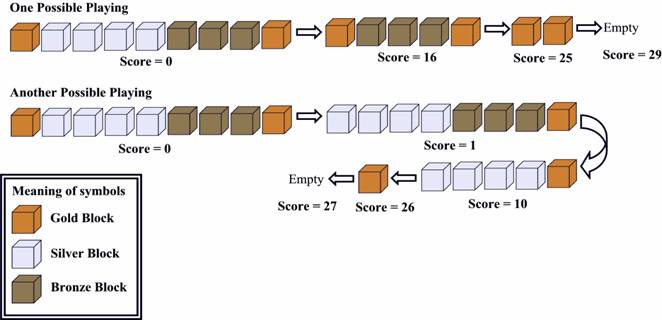本文主要是介绍Blocks(poj 1390) 动态规划 方盒游戏 (升维——三维),希望对大家解决编程问题提供一定的参考价值,需要的开发者们随着小编来一起学习吧!
Blocks 点击转到
| Time Limit: 5000MS | Memory Limit: 65536K | |
| Total Submissions: 6197 | Accepted: 2557 |
Description
Some of you may have played a game called 'Blocks'. There are n blocks in a row, each box has a color. Here is an example: Gold, Silver, Silver, Silver, Silver, Bronze, Bronze, Bronze, Gold.
The corresponding picture will be as shown below:

Figure 1
If some adjacent boxes are all of the same color, and both the box to its left(if it exists) and its right(if it exists) are of some other color, we call it a 'box segment'. There are 4 box segments. That is: gold, silver, bronze, gold. There are 1, 4, 3, 1 box(es) in the segments respectively.
Every time, you can click a box, then the whole segment containing that box DISAPPEARS. If that segment is composed of k boxes, you will get k*k points. for example, if you click on a silver box, the silver segment disappears, you got 4*4=16 points.
Now let's look at the picture below:

Figure 2
The first one is OPTIMAL.
Find the highest score you can get, given an initial state of this game.
Input
The first line contains the number of tests t(1<=t<=15). Each case contains two lines. The first line contains an integer n(1<=n<=200), the number of boxes. The second line contains n integers, representing the colors of each box. The integers are in the range 1~n.
Output
For each test case, print the case number and the highest possible score.
Sample Input
2
9
1 2 2 2 2 3 3 3 1
1
1Sample Output
Case 1: 29
Case 2: 1
1.题目含义:
N个方盒(box)摆成一排,每个方盒有自己的颜色。连续摆放的同颜色方盒构成一个方盒片段(box segment)。下图中共有四个方盒片段,每个方盒片段分别有1、4、3、1个方盒玩家每次点击一个方盒,则该方盒所在方盒片段就会消失。若消失的方盒片段中共有k个方盒,则玩家获得k*k个积分。
2. 以前背包问题,对于一件物品来说,拿不拿的问题。今天的方盒游戏,则是消不消的问题。(不消除,因该考虑用另外一个变 量保存当前长度——升维)
2.1消除:消除的话就是长度的平方,pow(lb[now].len,2);
2.2 不消除:不消除的情况下,就是合并。但是合并,就要考虑和哪个方块进行合并?(因为要得到的分数尽可能地高,所以假设与k块进行合并,就for(int k=i;k<=j-1;k++)循环一遍,找最大值)
3.课件解析:
递归终止条件: (i==j) ,也就是从i到j属于一个方块。
#include<iostream>
#include<algorithm>
#include<cstring>
#include<cstdio>
#include<queue>
#include<cmath>
#include<cstdlib>
using namespace std;
struct Block
{int color;int len;
};
Block b[210];
int s[210][210][210];
int getScore(int i,int j,int len)
{if(s[i][j][len]!=-1)return s[i][j][len];int sum=pow((b[j].len+len),2);if(i==j)return sum;sum=sum+getScore(i,j-1,0);//合并j块 for(int k=i;k<=j-1;k++)//合并j块后,形成新块与k块进行合并 {if(b[k].color!=b[j].color)continue;int sumk=getScore(k+1,j-1,0);sumk=sumk+getScore(i,k,b[j].len+len);sum=max(sumk,sum);}s[i][j][len]=sum;return sum;
}
int main()
{int T;cin>>T;for(int t=1;t<=T;++t){int n;memset(s,0xff,sizeof(s));cin>>n;int lastcolor=0;int r=-1;for(int i=0;i<n;i++){int c;cin>>c;if(c!=lastcolor){r++;b[r].len=1;b[r].color=c;lastcolor=c;}elseb[r].len++;}cout << "Case " << t << ": " << getScore(0,r,0) << endl;}return 0;
}
这篇关于Blocks(poj 1390) 动态规划 方盒游戏 (升维——三维)的文章就介绍到这儿,希望我们推荐的文章对编程师们有所帮助!






